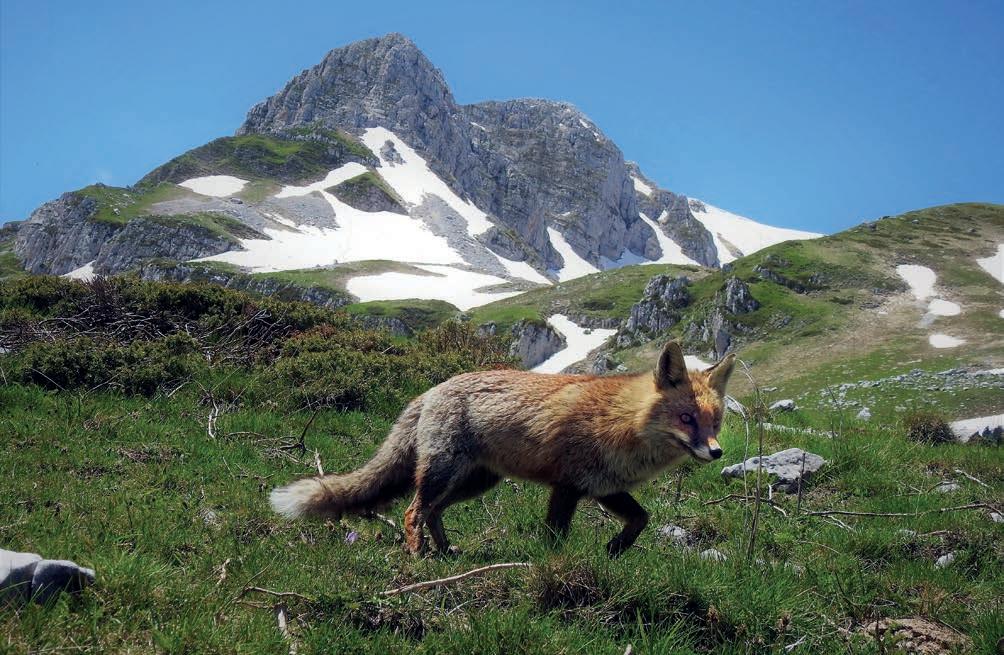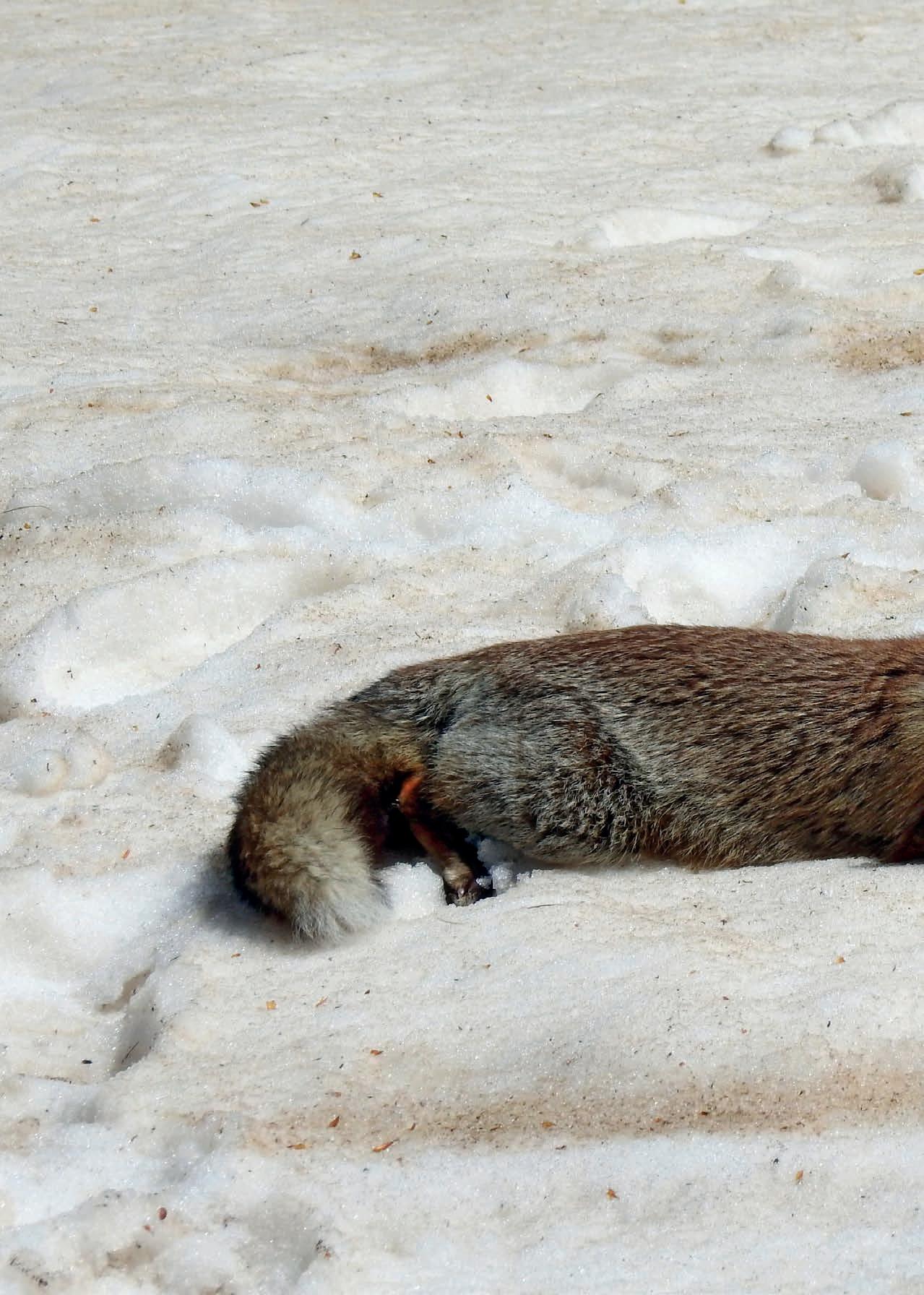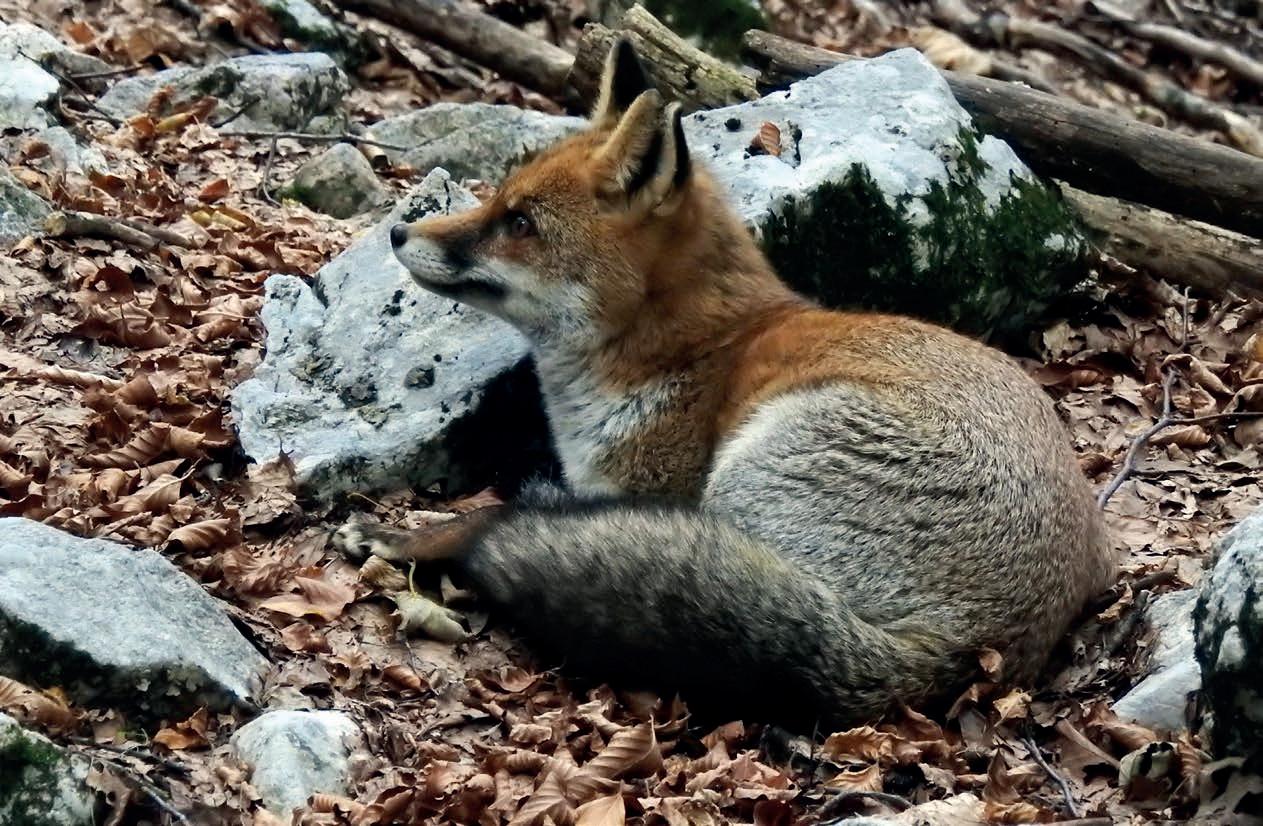
11 minute read
Furba e intelligente, la volpe è sempre più vicina agli uomini Cunning and intelligent, the fox is continuously getting closer to humans
Furba e intelligente, la volpe è sempre più vicina agli uomini
Cunning and intelligent, the fox is continuously getting closer to humans
Advertisement
Francesco Ventriglia Campana
UNA VOLPE IN CERCA DI PREDE TRA LE MONTAGNE ABRUZZESI AL DISGELO DOPO IL LUNGO INVERNO A FOX IN SEARCH OF PREY AMONG THE THAWING MOUNTAINS OF ABRUZZO AFTER A LONG WINTER
La famiglia delle volpi comprende 12 specie diverse, tra cui la volpe rossa, vulpes vulpes o semplicemente volpe, il mammifero selvatico più diffuso al mondo, unico rappresentante di questa specie nel nostro Paese e con una numerosa popolazione in Abruzzo. E’ un canide di medie dimensioni, ha il muso lungo e affusolato, le orecchie dritte, appuntite e nere nella parte posteriore. Ha un aspetto aggraziato e gradevole, con una folta pelliccia, una coda ampia e soffice, il colore del pelo che muta con le stagioni. È un animale dalle abitudini prevalentemente notturne, ma vive indisturbato anche di giorno, riparandosi sotto i cespugli, in piccoli The fox family is comprised of 12 different species, among which, the red fox, vulpes vulpes, or to put it more simply, the fox that is the most widespread wild mammal in the world and the only example that can be seen in our country with a large presence in Abruzzo. It is a medium sized canidae and it has a long and tapered muzzle and ears that are straight, pointy and black on the rear. It has a graceful and pleasant aspect with a bushy coat, a wide and soft tail and fur which changes with the seasons. It is a predominantly nocturnal animal, but it also roams around undisturbed du-
anfratti, nelle tane scavate da lui stesso o in tane di tassi o istrici abbandonate. È il carnivoro selvatico con la più vasta zona di distribuzione nell’intero pianeta, presente in tutta Italia anche se è poco comune nella pianura Padana. Si ritrova negli habitat più svariati, dal livello del mare sino all’alta montagna, compresi ambienti fortemente antropizzati. Addirittura, non disdegna la periferia e le aree verdi delle grandi città. Preferisce, comunque, boschi interrotti da radure, macchie e cespugli, specie se prossime a coltivazioni. Per vivere in una grande varietà di ambienti diversi, le volpi devono avere sviluppato considerevoli capacità di adattamento.
La sua alimentazione è rappresentata da lepri, conigli, piccoli roditori, ricci, ma tende ad escludere i toporagni e le talpe. Si ciba, inoltre, di insetti, uccelli, uova, lombrichi, carogne e rifiuti. In estate e in autunno, integra la sua dieta con frutti selvatici e bacche. Le sue esigenze alimentari sono di circa 500 grammi di cibo al giorno. Le volpi sono solite cacciare da sole. Non inseguono le prede, ma adottano la tecnica dell’appostamento per balzare loro addosso in maniera repentina e precisa, anche nell’erba folta, grazie a un udito finissimo che permette di localizzare piccoli animali con estrema precisione. Quando riescono a procurarsi più cibo di quello che serve loro per l’immediato, seppelliscono il surplus in piccole buche di 15-20 centimetri, mai in un’unica buca dispensa, in modo che se qualcuna viene scoperta da qualche altro animale, hanno sempre le altre come riserva.
Le volpi sono oltremodo opportuniste e non è raro che si avvicinino all’uomo in luoghi molto frequentati dagli escursionisti, in cerca di cibo, arrivando perfino a prendere dei bocconi dalle mani. Si tratta della cosiddette volpi confidenti, presenti sempre più spesso in molte località. Questo fenomeno non andrebbe incoraggiato, perché non si dovrebbe fornire cibo agli animali selvatici, ma per molti è difficile resistere alla tentazione di un selfie mentre si imbocca una volpe.
Normalmente le volpi vivono in coppia, con i cuccioli, anche se talvolta è possibile osservarne esemplari ring the daytime by sheltering itself under bushes, nooks and crannies, in self-dug hideouts or burrows abandoned by badgers or porcupines. It is a wild carnivore with the widest distribution area on the planet. Although it is less common in the Padana plains it is, on the other hand, present throughout Italy. It can be found in many places ranging from sea level locations to mountain tops including strongly anthropized environments. It doesn’t even disdain the outskirts and green areas of large cities. It does, however, prefer woods to clear, scrubs and bushes, especially if near crops. In order to survive the multiple types of environments, foxes must have developed meaningful adaptation skills.
Its diet includes hares, rabbits, small rodents and hedgehogs, but it tends to refuse shrews and moles. In addition, it feeds on insects, birds, eggs, earthworms, carcasses and waste. It integrates its diet with wild fruits and berries in Summer and Autumn. Its dietary requirements are about 500 grams of food a day. Foxes usually hunt alone. The don’t follow their prey, but they adopt the ambush technique of pouncing on them suddenly and precisely, even in heavy grass, due to their sensitive hearing which allows them to pinpoint animals with perfect precision. When they are able to procure more food than what they need in that moment, they bury the surplus in small 1520 cm holes but never in a single one. The reason lies in the fact that they will always have reserves if the food is discovered by another animal. Foxes are opportunists, and on several occasions, they come into contact with humans in locations that are popular with hikers so as to search for food. They even go as far as taking a mouthful of food from people’s hands. We are obviously talking about the so called confident foxes that are getting spotted more and more in different locations. This phenomenon shouldn’t be encouraged because food mustn’t be given to wild animals, but for many, it is difficult to resist the temptation of getting a selfie while giving food to a fox. Normally foxes live in pairs with
MALVISTA E SCREDITATA SPESSO CACCIATA PERCHÈ CONSIDERATA DANNOSA SI È ADATTATA A VIVERE ANCHE NELLE PERIFERIE DELLE GRANDI CITTÀ
UNPOPULAR AND DISCREDITED IT IS OFTEN HUNTED DOWN AS IT CONSIDERED TO BE DAMAGING IT HAS ADAPTED TO LIVING ON THE OUTSKIRTS OF LARGE CITIES


solitari o in gruppi di 4 o 6 adulti. Il maschio marchia il territorio in modo sistematico, oltre che con l’urina, con una sostanza odorifera secreta da una ghiandola posta vicino alla coda. Comunica con i propri simili con segnali sonori, visivi, tattili e olfattivi. Una volpe può riconoscere un altro esemplare dall’odore, oltre a identificarne il rango gerarchico e il livello sociale. In genere, la coppia tende a riformarsi ogni anno e il maschio solitamente partecipa attivamente alla cura e all’allevamento della prole, procurando il cibo e difendendo i cuccioli da possibili predatori.
Il periodo degli amori è molto variabile e cambia secondo la latitudine: in Italia ha luogo in inverno, tra dicembre e febbraio. I parti avvengono generalmente tra marzo e aprile. La femmina, dopo una gestazione di 7 settimane, partorisce, in una tana, in media da 3 a 5 piccoli, che vengono allattati per un mese. AI termine di questo periodo, i cuccioli iniziano a prendere i primi cibi solidi, costituiti da alimenti predigeriti dalla madre e poi rigurgitati. Questa tecnica è molto vantaggiosa poiché permette di nutrire la cucciolata senza portare le carcasse vicino alla tana e nel contempo fa sì che i piccoli non debbano spostarsi alla ricerca di cibo, che li esporrebbe ai pericoli. Durante le prime due settimane di vita, la madre non abbandona i cuccioli, si dedica interamente al loro allattamento e viene nutrita dal maschio. La femmina non esita a their cubs, even if it is sometimes possible to see them by themselves or in groups of 4 or 6 adults. The male marks his territory in a systemic way, not only with his urine but also with an odorous substance secreted from a gland located near the tail. It communicates with its counterparts through sound signals, visuals, touch and smell. A fox can recognize another specimen by its smell, as well as identify the hierarchical rank and social level. Generally the couple tends to reform itself every year and the male usually participates actively in taking care and bringing up the offspring by getting hold of food and defending the cubs from possible predators.
The mating season is extremely changeable and varies according to the latitudes: Winter takes place in Italy between December and February. Births generally occur between March and April. After a 7 week gestation, the female gives birth to an average of 3 to 5 cubs in a burrow, who are then fed for a month. At the end of this period, the cubs begin to consume their first solid foodstuffs that are predigested by the mother beforehand and then regurgitated. This technique is very advantageous because it allows her to feed her little ones without taking the carcasses near the hideout, and over time, the cubs don’t have to go too far in search of food, which can expose them to many dangers. In the first

È IL MAMMIFERO SELVATICO PIÙ DIFFUSO AL MONDO MOLTO PRESENTE SUI MONTI ABRUZZESI SI TROVA DI RADO NELLA PIANURA PADANA PROTAGONISTA DI TANTI PROVERBI ED ESPRESSIONI COMUNI
trasportare in luoghi più sicuri i propri piccoli se, nei pressi della tana, vengono a crearsi fattori di disturbo. I piccoli escono dalla tana per la prima volta intorno alla quarta o quinta settimana e sono molto giocherelloni. La vita media di una volpe si aggira attorno ai 3-4 anni, ma in talune favorevoli e fortunate circostanze può raggiungere gli 8-10 anni.
Il principale nemico della volpe è l’uomo, che la perseguita da sempre. La caccia alla volpe è stata purtroppo molto praticata sia per puro divertimento, come la famosa caccia in uso in Gran Bretagna, sia perché veniva considerato un animale nocivo, in quanto è particolarmente abile a penetrare nei pollai. Anche oggi i contadini sanno bene che i loro pollai devono essere ben protetti dalle insidie di questo scaltro animale, che approfitta di qualunque falla nella struttura per introdurvisi e fare razzia.
Considerata da sempre come l’incarnazione della furbizia, la volpe pur avendo goduto di una certa simpatia o quasi ammirazione, si è prestata come protagonista di numerose fiabe e storie con risvolti etici quasi sempre negativi, e questo ha contribuito non poco a renderla malvista e a screditarla come è avvenuto anche con il lupo, giustificando ogni mezzo di persecuzione.
Ancora oggi si usano delle espressioni che si richiamano a favole di Esopo o altri classici , di cui la volpe è protagonista: “fa come la volpe con l’uva” (chi non potendo raggiungere una cosa, finge di disprezzarla); più spesso è presa come termine di paragone di persona molto astuta: “è una vecchia volpe”; “tutte le volpi alla fine si ritrovano in pellicceria” (i furbi un giorno o l’altro vengono gabbati): “mangiare pane e volpe” ( essere educato da persone perspicaci). S two weeks of life, the mother doesn’t abandon the cubs and dedicates herself entirely to their feeding. She, in turn, is given food by the male. The female won’t hesitate moving her cubs to safer locations if she feels there are some disturbing factors around the hideout. The cubs come out of the burrow for the first time in the fourth or fifth week and are very playful. The average life of a fox is around 3-4 years, but in some favourable and fortunate circumstances, they can also reach 8-10 years of age.
Mankind has continuously persecuted foxes and for this reason, is considered to be the fox’s main enemy. Unfortunately fox hunting has been carried out for a long time for pure fun, as can be seen in Great Britain, but also due to the fact that they are considered to be harmful since they are capable of entering henhouses. Even today, farmers know full well that their henhouses must be well protected from the hidden dangers of this astute animal, who takes advantage of any flaws in a facility to enter and raid the place.
Although the fox has enjoyed some amount of fondness, or to some extent, admiration, it has always been considered to be the incarnation of astuteness and for this reason, it has been subjected to numerous fairy tales and stories with occasional negative ethical consequences. This has contributed to its negative perception just like the wolf and thus, persecutions against them have always been justified.
Nowadays expressions are still used that recall Aesop’s fables or other classics where the protagonist is the fox: “fa come la volpe con l’uva” (who can’t achieve a thing pretends to despise it); more often than not it is used as a term to compare astute people: “è una vecchia volpe”; “tutte le volpi alla fine si ritrovano in pellicceria”(smart people, one day or another, will end up rendering accounts): “mangiare pane e volpe” (to be shrewd people). S
IT IS THE MOST WIDESPREAD MAMMAL ON EARTH AND CAN BE SEEN ON THE ABRUZZO MOUNTAINS IT IS SELDOMLY FOUND ON THE PADANA PLAINS IT IS THE PROTAGONIST OF MANY PROVERBS AND POPULAR EXPRESSIONS










